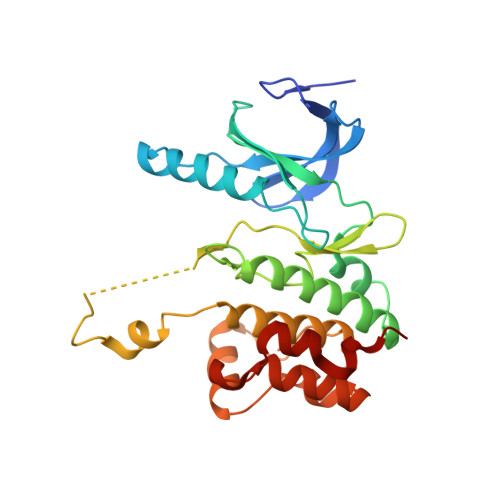Discovery and Characterization of Allosteric WNK Kinase Inhibitors.
Yamada, K., Zhang, J.H., Xie, X., Reinhardt, J., Xie, A.Q., LaSala, D., Kohls, D., Yowe, D., Burdick, D., Yoshisue, H., Wakai, H., Schmidt, I., Gunawan, J., Yasoshima, K., Yue, Q.K., Kato, M., Mogi, M., Idamakanti, N., Kreder, N., Drueckes, P., Pandey, P., Kawanami, T., Huang, W., Yagi, Y.I., Deng, Z., Park, H.M.(2016) ACS Chem Biol 11: 3338-3346
- PubMed: 27712055
- DOI: https://doi.org/10.1021/acschembio.6b00511
- Primary Citation of Related Structures:
5TF9 - PubMed Abstract:
Protein kinases are known for their highly conserved adenosine triphosphate (ATP)-binding site, rendering the discovery of selective inhibitors a major challenge. In theory, allosteric inhibitors can achieve high selectivity by targeting less conserved regions of the kinases, often with an added benefit of retaining efficacy under high physiological ATP concentration. Although often overlooked in favor of ATP-site directed approaches, performing a screen at high ATP concentration or stringent hit triaging with high ATP concentration offers conceptually simple methods of identifying inhibitors that bind outside the ATP pocket. Here, we applied the latter approach to the With-No-Lysine (K) (WNK) kinases to discover lead molecules for a next-generation antihypertensive that requires a stringent safety profile. This strategy yielded several ATP noncompetitive WNK1-4 kinase inhibitors, the optimization of which enabled cocrystallization with WNK1, revealing an allosteric binding mode consistent with the observed exquisite specificity for WNK1-4 kinases. The optimized compound inhibited rubidium uptake by sodium chloride cotransporter 1 (NKCC1) in HT29 cells, consistent with the reported physiology of WNK kinases in renal electrolyte handling.
Organizational Affiliation:
Novartis Institutes for BioMedical Research, Inc. , Cambridge, Massachusetts 02139-4133, United States.


















